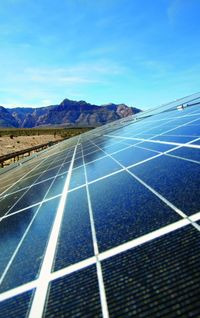Private credit in Latin American project finance had a breakout year in 2024. The Aguas Esperanza water pipeline deal in Chile highlighted one of the favoured structures. By Nic Stone
The growth of private credit has been one of the main stories in financial markets over the past decade and the new kid on the block seems to have found a friendly welcome in Latin American infrastructure financing.
The past few years have seen private debt providers help to prop up major infrastructure programmes across the region, while the project finance market has worked to incorporate structures that allow for the capital to play more readily.
From small-scale solar in Chile, to bridges over the Panama Canal, to sustainable water projects bringing seawater from the Pacific to inland Chile to help make mining more sustainable, the projects offer capital providers worthwhile stories, while the premium in pricing for Latin American deals also helps to assuage private credit’s appetite for juicy returns.
The major progress made in 2024 was the incorporation of private placements into infrastructure financing more seamlessly, aided by the addition of fresh capital and new players. Deals closed at regular intervals throughout the year and a pattern emerged in structuring, with a sweet spot emerging in terms of sizing.
“Private credit sources such as infrastructure funds are taking an increasing role in project finance globally, including in Latin America,” according to Rebecca Roman at Sao Paulo-based law firm Stephen Hood & Partners. “Private credit lenders tend to have more flexibility in terms of structure, applying bespoke infrastructure financing models, and risk appetite.”
The showcase deal
The north of Chile is full of minerals critical to decarbonisation and is devoid of water. The microscope has been on miners working in the region to operate in a more sustainable way, which has meant a turn to desalination and water conveyancing projects.
In June, sponsors Almar Water Solutions, part of Abdul Latif Jameel, and local transmission group Transelec, through joint venture Aguas Esperanza, closed a US$1.56bn financing package backing a water conveyancing project connecting to the Antofagasta majority-owned Minera Centinela and Minera Antucoya copper mines, as well as the underdevelopment Nueva Centinela expansion in Antofagasta.
The financing highlighted the type of project and sizing that hits the sweet spot for incorporating private credit into Latin American deals, with a good story and strong sponsor group key for pulling it together. Something that happened again and again in 2024.
The financing included a US$1.35bn project finance debt package split between a syndicated commercial bank loan, private placement and letter of credit. The US$635m 12-year term loan and US$635m placement were sized the same, with BBVA, Santander, Intesa, KfW, Natixis and Credit Agricole on the bank tranche and The Carlyle Group, Denham, Allianz and Hanwha Group on the private tranche.
The same banks apart from BBVA provided the US$81m letter of credit and hedges. There was a separate US$216m equity bridge financing provided by Scotiabank to Transelec for its share of the equity. Macquarie Capital acted as exclusive financial adviser and sole placement agent to Aguas Esperanza.
There is a separate performance bond financing in which Santander has agreed to issue performance bonds under the offtake agreement at Antofagasta Mineral’s Centinela mine. Latham & Watkins and Barros & Errazuriz advised the sponsors, Milbank and Cuatrecasas advised the banks and lenders.
“The private credit market has developed worldwide and in Latin America it is continuing to develop, with pension and insurance companies increasingly looking to transact,” says one dealmaker who has transacted on private placement deals in the region.
The project will begin operations in 2026 following a 20-month construction period. Work includes the acquisition, refitting, and operation of a 144km water pipeline to transport more than 110,000m3/day, supplying seawater to the Antofagasta and Marubeni mines in the region, including Nueva Centinela, which will add 144,000 tonnes of copper, 3,500 tonnes of molybdenum and 130,000 ounces of gold extraction per year.
Minera Centinela closed the traditional US$2.5bn Nueva Centinela project financing earlier this year. The financing was key to getting the Aguas Esperanza deal done and to financial close, according to a source on the deal, as it meant the offtake situation was on more solid ground.
On Nueva Centinela the Japan Bank for International Cooperation, Export Development Canada, Export-Import Bank of Korea, and KfW IPEX-Bank were the development banks, while Credit Agricole, Natixis, Societe Generale, and SMBC were the commercial banks.
The water pipeline deal was sold as a private placement or 4(a)(2) bond tranche, which has become a preferred structure of late for financings backing infrastructure assets in the investment-grade countries in the region.
“The structure has been around for some time, but it is useful in the context of these transactions that are perhaps not big enough for the 144A market,” said one source on the deal.
“Below US$300m is a tough place to transact. Plus it is helpful as the 4(a)(2) structure allows for delayed draws. With a 144A if you are not deploying money right away you are paying interest, whereas this is more akin to a loan with a commitment fee.”
Where the action is
In the same month the bond was closing backing the water pipeline, BlackRock closed a US$155m 4(a)(2) bond private placement and an US$18m letter of credit facility refinancing three-year bank debt provided by BNP Paribas and Natixis on a 200MW operational portfolio of small-scale PMGD solar projects also in Chile.
The same banks were placements agents on the bond issue to Denham, HSBC Asset Management, IFM, Manulife, MetLife Investment Management, and Pension Insurance Corporation. Latham & Watkins advised the purchasers of the notes. BNP Paribas and Natixis provided the LC.
BNP Paribas and Natixis arranged the original US$300m revolving credit facility deal in early 2024, which was always expected to be taken out by a bond deal. It has now been replenished by this deal.
The financing is expected to be the first of multiple private placements refinancing the revolver and recycling capital into the PMGD space in Chile. The LC will cover debt service reserve accounts.
French IPP Reden Solar closed a US$135m 4(a)(2) private placement of senior notes refinancing project finance debt backing two portfolios of small-scale PMGD solar projects. The combined portfolios include 31 projects delivering 177MW of power.
In 2020 and 2019, Reden closed US$81m and US$96.4m financings through Natixis backing the PMGD projects, which have now been taken out by the long-term bond deal. Clifford Chance and Larrain y Asociados advised Reden.
“Now there have been so many of these deals, the banks are becoming very skilled at getting them done,” said one source. “They negotiate on behalf of the investors then typically present them with a deal that is roughly 90% done, before the investors come back with key points.”
Consorcio Panama Cuarto Puente, through special purpose vehicle Panama Infrastructure Receivable Purchaser, closed a US$119m 4(a)(2) debt private placement backing construction of the US$1.3bn fourth bridge over the Panama Canal in March.
Mizuho and Banistmo were structuring agents on the deal, advised by Latham & Watkins. Lumina Capital bought the deal. Santander was set to be part of the group but withdrew. The senior secured notes are due in 2026 and were issued under a multi-tranche structure allowing additional notes to be issued to finance the remainder of the works, which are now underway.
Panama Infrastructure Receivable Purchase is an orphan SPV backed by the consortium, which features China Communications Construction Company and China Harbour Engineering Company.
As institutions look for yield and increase their activity in Latin America, the private placement market is providing a more readily available way for capital providers to transact.
New sectors and new players
Data centre growth is a global phenomenon, and Latin America is doing its part with sponsors including I Squared Capital and Scala operating in the region. Private credit is well suited to the projects.
“Another trend seen within private credit is greater interest by these funding sources in the new types of infrastructure such as digital assets, telecoms, fibre optics, broadband, data centres and social and smart infrastructure as well as the related move to finance portfolios of assets through securitisations and holdco/mezzanine level debt,” said Stephen Hood & Partners' Rebecca Roman.
Data centres are expected to require some US$10bn per year in Latin America by the end of the decade, which could provide another sweet spot for private credit.
“The fact is that very few of the data centre financings have been done on a non-recourse or limited-recourse basis in the region … the growth in the sector is so strong that companies are beginning to diversify their investment and financing sources, especially as projects become problematic to develop, due to constraining power and water supplies,” according to Martin Menski, James Johnson, and Amaury de Feydeau in a note put out by White & Case.
“The time is ripe for the industry to look beyond current equity-focused investments and explore whether there are financing options beyond real estate transactions. Given the vast greenfield infrastructure needs of data centres in Latin America, project financing solutions – whether through loans or bonds – may be viable methods to support the capex needs of the digital infrastructure growth of Latin America.”
New players will also emerge and new funds are being raised all the time. “Private markets are seeking opportunities to expand private credit funding to other sectors, including asset-based finance and project finance, which offer much larger investment opportunities at higher rates of return,” according to a recent S&P report from Evan Gunter and Ruth Yang.
Patria Investments, for example, is in the process of raising a new R$5bn (US$1bn) infrastructure credit fund to focus on Brazil, which will invest in infrastructure debentures for smaller scale projects in sectors like energy transition, water and waste management, and urban mobility.
It quickly raised R$1bn from Brazilian development bank BNDES, the Development Bank of Latin America and the Caribbean (CAF), the International Finance Corporation, and others, which highlights the critical nature those stalwarts of project finance in the region will play in the new paradigm.
“The fund is quite innovative, given that it will be able to finance projects through customised structures, appropriate to the characteristics of each project,” said Marcelo Souza, partner and head of infra core, infra credit and energy infrastructure strategies in Brazil at Patria.
To see the digital version of this report, please click here.
To purchase printed copies or a PDF of this report, please email leonie.welss@lseg.com














